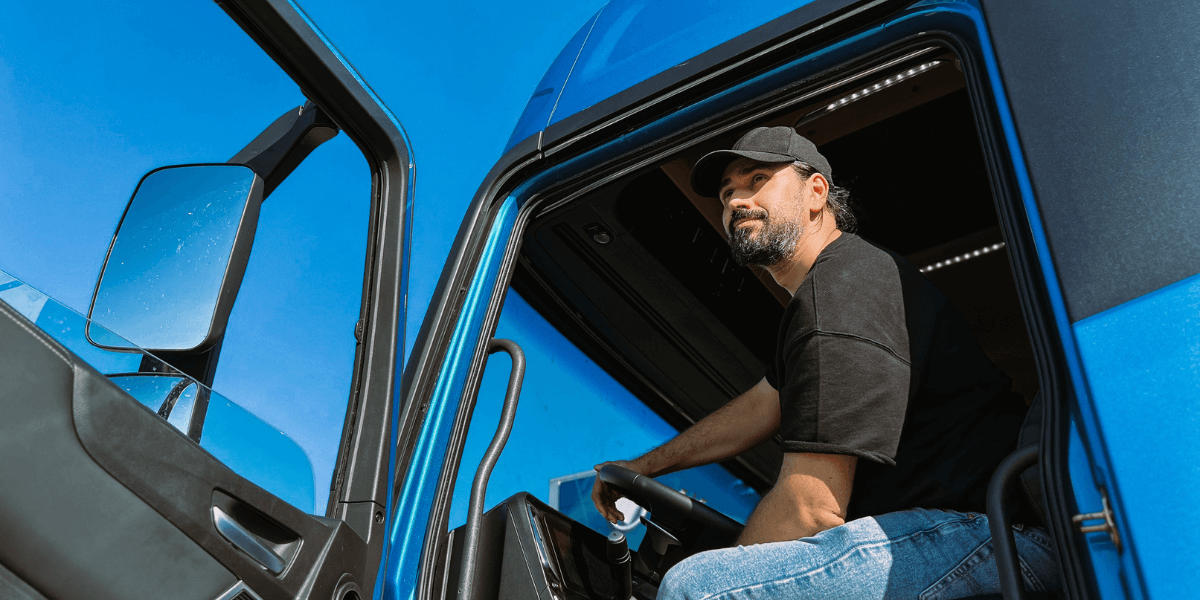Lower your internet bill
61% of people overpay for their internet.
Are you one of them?
Unlock exclusive offers in your area!
Call now
[tel]Enter zip code
1 Star is Poor & 5 Stars is Excellent.
* Required

Written by Caroline Lefelhoc - Pub. Oct 24, 2025 / Updated Oct 24, 2025
Table of Contents
Are you happy with your Internet service?

About the author
Life on the road needs reliable connectivity. Checking load boards, video chatting with family, and streaming Hulu after a long haul all need a reliable, travel-friendly internet connection. Truck drivers face unique internet challenges that office workers never encounter: crossing dead zones, burning through data caps, and dealing with spotty coverage in remote areas. We’ve put together our suggestions for the top internet providers for truck drivers so you can confidently choose a provider and connection type.
61% of people overpay for their internet.
Are you one of them?
Unlock exclusive offers in your area!
Call now
[tel]Enter zip code

Your on-the-road options
Mobile hotspots are a favorite for many truckers. These portable devices create WiFi networks using cellular data. Think of them as pocket routers that tap into carrier networks to distribute internet access to your devices.
Major carriers like Verizon, T-Mobile, and AT&T offer dedicated hotspot devices with various data plans. These standalone units outperform smartphone hotspots in several ways. They deliver stronger signals, connect more devices simultaneously, and won’t drain your phone battery. Many models support 20 or more connected devices at once, perfect if you’re running multiple screens or sharing with a co-driver.
The key advantage? Flexibility. You control your setup, choose your carrier based on your routes, and take your connection anywhere. The downside? Data caps remain a real concern. Most unlimited plans throttle speeds after you hit certain thresholds—frustrating when you’re trying to stream content after a long day.
When selecting a hotspot, coverage matters more than features. Check carrier coverage maps against your typical routes. A device with premium features becomes worthless in areas where your carrier lacks towers. Many drivers maintain backup options with different carriers to ensure connectivity in coverage gaps.
Your smartphone’s hotspot feature is the easiest way to get online while traveling. All modern smartphones includes this functionality, and if you already pay for an unlimited data plan, you’re ready to go. Major carriers like Verizon, T-Mobile, and AT&T provide widespread nationwide coverage, delivering stable connections across most areas.
The convenience factor wins here. No additional devices to charge, no separate bills to manage, and no learning curve. Just toggle your hotspot on and connect your laptop or tablet. For drivers who need occasional internet access for emails and basic browsing, this approach works perfectly fine.
However, limitations emerge quickly under heavy use. Smartphone hotspots typically offer limited high-speed data each month—often just 10-15GB before speeds drop significantly. Your phone battery drains rapidly when acting as a hotspot, requiring constant charging. Connection quality suffers in remote areas compared to dedicated hotspot devices with stronger antennas.
The biggest drawback? You can’t make calls or use your phone normally while it’s serving as a hotspot without eating into your data allowance. For drivers who need consistent connectivity throughout their workday, smartphones are better backup solutions than primary internet sources.
Data caps create constant anxiety for truckers. Unlimited data plans promise freedom from overage fees and throttling warnings, but reading the fine print is necessary. Most “unlimited" plans include gotchas that affect real-world performance.
Premium unlimited plans from major carriers typically provide 40-50GB of high-speed hotspot data before throttling kicks in. Once you cross that threshold, speeds drop significantly—barely functional for video streaming or large downloads. Some plans deprioritize your data during network congestion, meaning your connection slows when towers get busy.
When evaluating unlimited plans, calculate your typical monthly data usage. If you’re streaming video daily, gaming online, or downloading large files, spring for premium plans with higher hotspot allowances. Light users will find budget unlimited plans perfectly adequate.
When cellular towers disappear satellite internet steps in. This technology provides coverage in areas where terrestrial networks fail completely. For drivers who frequently haul through remote regions, satellite options are one of you best bets.
Starlink, SpaceX’s satellite internet service, has revolutionized mobile connectivity. The system delivers speeds between 100-200Mbps with latency around 60ms—performance that rivals cable internet. Drivers using Starlink report reliable connections even in areas where cellular service vanishes entirely. Some truckers mount dishes on their truck roofs with specialized brackets, creating semi-permanent installations that simplify setup.
You can check out Starlink’s plans, pricing, and information here.
Traditional satellite providers like HughesNet and Viasat offer coverage, too, but their high-orbit satellites create significant latency issues. Response times of 600ms or more make video calls choppy and online gaming impossible. These services work for basic browsing and email, but struggle with real-time applications.
The biggest satellite drawback? Setup complexity. You’ll need clear skies, proper dish alignment, and time to establish a connection. Weather can degrade signals, unfortunately, and moving between locations requires reorientation, which many drivers find annoying.
Signal boosters amplify weak cellular signals, pulling connectivity from distant towers that your devices can’t reach alone. These systems work with any carrier and improve performance for both calls and data. For drivers who frequently travel through areas with limited coverage, boosters turn frustrating connectivity into usable service.
A typical booster setup includes an external antenna mounted on your truck’s exterior, an amplifier unit inside your cab, and an internal antenna that broadcasts the boosted signal. The external antenna captures weak signals from distant towers, the amplifier strengthens them, and the internal antenna distributes improved connectivity throughout your workspace.
Quality boosters cost $200-500, but they work with your existing phone and carrier. You’re not adding another monthly bill—just enhancing the service you already pay for.
Installation requires basic technical skills and a few hours. Mount the external antenna as high as possible on your truck for best performance. Route cables to your amplifier location. Position the internal antenna where you need coverage. Most drivers complete installations themselves, though professional installation services exist if needed.
Boosters won’t create connectivity where absolutely none exists, but they excel at improving marginal signals into usable ones. In areas with one or two bars, boosters often deliver full-strength connections. Combined with a solid data plan, they create surprisingly reliable coverage even on remote highways.

The last resort
Truck stops across America offer WiFi access, and the price—free or minimal—creates obvious appeal. Love’s, Pilot Flying J, and TA locations typically provide wireless access to drivers. It solves immediate connectivity needs without monthly bills or equipment investments.
The reality doesn’t match the convenience. Public WiFi networks usually have slow speeds because so many people are using them, especially during peak hours when a lot of drivers are settled in for the night. Streaming The Great British Baking Show on Netflix will feel like a frustrating and semi-impossible task.
Security poses bigger concerns. Public networks lack encryption, leaving your data vulnerable to interception. Banking, shopping, and work logins are vulnerable when using open Wi-Fi. Hackers will even sometimes create fake networks at truck stops, capturing login credentials from unsuspecting users.
If you use public WiFi, follow basic security practices. Connect through a VPN to encrypt your traffic. Avoid accessing sensitive accounts or making financial transactions. Use it for casual browsing and non-critical tasks only. Never rely on public WiFi as your primary connectivity solution.
Ready to find an internet provider for you? You can browse our internet provider reviews here to see which option is your best bet for on the road.
If you’re looking for connectivity at your home base when you’re not on the road, you can enter your zip code below, and a list of top providers and plans available in your area will generate.
61% of people overpay for their internet.
Are you one of them?
Unlock exclusive offers in your area!
Call now
[tel]Enter zip code
You can use our comparison tool to compare provider speeds, pricing, and features to find the perfect match for your needs when you’re not behind the wheel.
Can truck drivers get WiFi in their trucks?
Yes, truck drivers have multiple WiFi options. Mobile hotspots create WiFi networks using cellular data, working with major carriers like Verizon, T-Mobile, and AT&T. Satellite internet, like Starlink, provides connectivity in remote areas. Some drivers use smartphone hotspots for basic connectivity. Many newer trucks feature built-in connectivity options, though most drivers still need to arrange their own internet solutions.
Does Starlink work while driving?
Standard Starlink systems require a stationary setup and won’t work while your truck is moving. However, Starlink offers in-motion capability with its premium Mobile Priority plans, though these cost significantly more at $250+ per month and require expensive equipment. Most truckers use Starlink during rest stops and rely on cellular data while driving, combining both solutions for comprehensive coverage.

About the author
Congratulations, you qualify for deals on internet plans.
Speak with our specialists to access all local discounts and limited time offers in your area.
[tel]61% of people overpay for their internet.
Are you one of them?
Unlock exclusive offers in your area!
Call now
[tel]Enter zip code